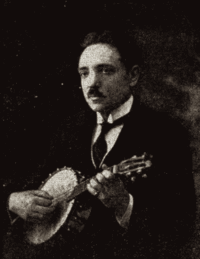Salvator Léonardi

Salvator Léonardi (born Catania, Italy 1872 – died 1938) was a mandolin virtuoso, teacher and composer. He taught in Egypt, Malta, London and Paris for more than 20 years, and also toured as a performer. Léonardi learned mandolin and guitar from an uncle, but went on to become a professional musician, studying the violin at a Naples conservatory. He won awards as a solo mandolinist at international music competitions in Florence and Rome.[1][2][3]


Léonardi was the author of the Méthode pour Banjoline ou Mandoline-Banjo (Method for Banjolin and Mandolin-Banjo). The book was rare among texts teaching mandolin, because it taught his method in three languages at once, English, French and Spanish. In the third edition of his mandolin-banjo method (1921), he stated in the introduction that the mandolin had been declining in popularity from previous times. In writing his book, he noted the instrument was soaring in popularity in the shape of the banjo. He did not just recycle old material for his book, but also included his own compositions, including Souvenir de Malta, Caminando (a tango), Souvenir de Rome, Un Beso Por Teléfono, Qui-Pro-Quo, Rêverie, and Capriccio (a polka).[4]
As a music teacher, Léonardi was unsure of whether to include jazz in his book, saying he thought it a faddish style of playing that might not be around very long. In spite of his speculation, he chose to include the section on how to play jazz, noting that he had played with American jazz bands after World War I.[4]
He is known for composing Souvenir de Catania, Souvenir de Napoli, Souvenir de Sicile, and Angeli e Demoni.[1][2]
Compositions
- Souvenir de Sicile[3]
- Souvenir de Naples[3]
- La bella sorrentina for mandolin with guitar or piano[3]
- Angeli e demoni for mandolin[3]
- Cavalleria rusticana
- Valse Fantastique
- Love Song Op. 275
- Danza Dei Nani Op. 43
- Caprice Italien (waltz)
- Caprice Spagnuolo Op. 276
- La Mystérieuse Valse (waltz)
- L'entrée des gladiateurs
See also
References
- 1 2 Aulino Editore, In preparizione: Salvator Leonardi, Souvenir de Cicile
- 1 2 Mandos Island, Salvatore Leonardi “Souvenir de Sicile” & “Angels and Daemons” – Mandolin / Liuquin
- 1 2 3 4 5 Paul Sparks, The Classical Mandolin, Oxford University Press, 1995, pages 79, 148.
- 1 2 Salvator Léonardi, Méthode pour Banjoline ou Mandoline-Banjo, Paris, 1921
External links
- Introduction to Leonardi's Method for Mandolin book
- Page with mandolin and mandolin-banjo method books in public domain
- Page with banjo instruction manuals, including Salvatore Léonardi's Method for Zither Banjo (French)
|